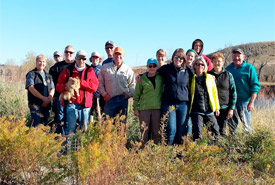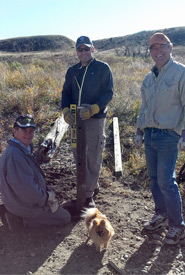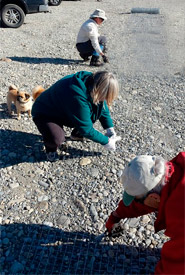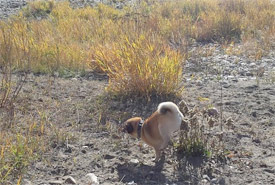Down by the river

Group shot from CV event on Legacy Island, AB (Photo by Amy McClelland)
Volunteering for the Nature Conservancy of Canada (NCC) and Trout Unlimited tree planting and clean up on Legacy Island was a great learning experience for me. I feel like I contributed to helping keep our province beautiful for years to come. And the lovely fall Alberta weather co-operated also.
About an hour’s drive from Calgary, Legacy Island is situated along the Bow River, and is one of the areas that was damaged by the 2013 southern Alberta flood. The riverbanks are steep bluffs, and the cliffs that overlook the clear running water were once used as buffalo jumps. The floodwaters also exposed some previously unknown artifacts that are now being studied.

Some happy gate-builders and a little helper! (Photo by Amy McClelland)
When I arrived at Legacy Island, I was greeted by Kailey from NCC, and met some of the other volunteers. We were given a short update on what our role would be that day and why. Since large cottonwood poplars that grow on the island were knocked down during the flood, we were given the task of planting 150 cottonwood saplings. The trees provide protection and habitat for the island’s residents — deer, pheasants, waterfowl, upland birds and a few beavers. Helping re-establish the cottonwood trees is an important part of keeping the area a protective natural habitat for these animals, as well as providing protection from the elements and from future floods.

Author Amy cutting fences with another volunteer at the event (Photo courtesy Amy McClelland)
Some of our local experts placed the plants in the grasslands, and the volunteers put the trees in their new homes. The little saplings were watered and staked and then protected by wire to prevent hungry critters from snacking on them before they are established.
Some volunteers also planted willow cuttings to help stabilize the soil. Willows required less staking, but are just as important when it comes to preventing erosion. They keep the fine silts from hanging in suspension in the water, which helps our fish friends as well.
A few volunteers identified an area where vehicles were travelling across the island and causing damage to the natural landscape. So, they decided to build a gate to deter vehicles from entering part of the island. It was a great day to be outdoors and enjoying the company of some very interesting people.

Sugar had her own method of culling invasive plants (Photo by Amy McClelland)
I have never enjoyed having a burr stuck to my clothing and so it was my pleasure to help with removing some of these plants once we were done planting, because I don't think the natural inhabitants enjoy them either. The burdocks were huge and we could have used another day to go after these guys en masse to get them all. Black henbane was also spotted, which is a poisonous plant to wildlife. Interesting fact: the scientist who invented Velcro was inspired by burdock.
The things you learn when you volunteer!


